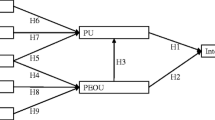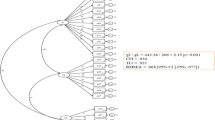Abstract
The quality of healthcare is highly dependent on nurses’ performance and efficiency. In recent years, hospital information systems (HIS), healthcare software and applications have been introduced to enhance their ability and nurses have a key role in accepting and evaluating the HIS. This study tested psychometric properties and validation of a Persian version of the “Health Information Technology Usability Evaluation Scale” (Health-ITUES). Expert panel, which consisted of 10 nursing professors, assessed the content and face validity of the Persian Health-ITUES. Sample of the was 229 nurses employed in hospitals. Cronbach’s alpha was used to test reliability along with “confirmatory factor analysis” (CFA) was used to test construct validity. Further, both discriminant and convergent validity were assessed. Content validity index (CVI) and content validity ratio (CVR) were .93 and .75 respectively. Scale content validity index (S-CVI) and item content validity index (I-CVI) were more than thresholds (.76 and .90, respectively). Goodness of fit indexes revealed the measurement model was fitted to data well (χ2/DF = 2.49, IFI = .939, CFI = .938, GFI = .903, RMSEA = .076). Cronbach’s alpha values of the factors and total scale were ranged between .75 and .94. The results indicated that Persian version of the health-ITUES is a reliable and valid tool to measure information technology usability in nursing field. We recommend to researchers, health and nursing application developers to use iterative usability evaluation with HITUES to identify problems in early developing steps and address user-centered design.
Access this chapter
Tax calculation will be finalised at checkout
Purchases are for personal use only
Similar content being viewed by others
References
Tang C et al (2019) The influence of cultural competence of nurses on patient satisfaction and the mediating effect of patient trust. J Adv Nurs 75(4):749–759
Ammenwerth E et al (2011) Effect of a nursing information system on the quality of information processing in nursing: an evaluation study using the HIS-monitor instrument. Int J Med Informatics 80(1):25–38
Hao A et al (2006) Apply creative thinking of decision support in electrical nursing record. Stud Health Technol Inform 124:313–319
Rathert C et al (2019) Seven years after Meaningful Use: Physicians’ and nurses’ experiences with electronic health records. Health Care Manage Rev 44(1):30–40
Hsiao J-L, Chang H-C, Chen R-F (2011) A study of factors affecting acceptance of hospital information systems: a nursing perspective. J Nurs Res 19(2):150–160
Sharifian R et al (2014) Factors influencing nurses’ acceptance of hospital information systems in Iran: application of the Unified Theory of Acceptance and Use of Technology. Health Inf Manage J 43(3):23–28
Staggers N et al (2018) The imperative of solving nurses’ usability problems with health information technology. JONA J Nurs Admin 48(4):191–196
Yen P-Y, Bakken S (2012) Review of health information technology usability study methodologies. J Am Med Inform Assoc 19(3):413–422
Yen P-Y, Wantland D, Bakken S (2010) Development of a customizable health IT usability evaluation scale. In: AMIA annual symposium proceedings. American Medical Informatics Association
Kelbiso L, Belay A, Woldie M (2017) Determinants of quality of work life among nurses working in Hawassa town public health facilities, South Ethiopia: a cross-sectional study. Nurs Res Pract 2017
Nayak T, Sahoo CK (2015) Quality of work life and organizational performance: the mediating role of employee commitment. J Health Manag 17(3):263–273
Karahanna E, Straub DW (1999) The psychological origins of perceived usefulness and ease-of-use. Inf Manage 35(4):237–250
Lawshe CH (1975) A quantitative approach to content validity. Pers Psychol 28(4):563–575
Polit DF, Beck CT (2006) The content validity index: are you sure you know what’s being reported? Critique and recommendations. Res Nurs Health 29(5):489–497
Plichta SB, Kelvin EA, Munro BH (2013) Munro s statistical methods for health care research. Wolters Kluwer Health/Lippincott Williams & Wilkins
Schnall R, Cho H, Liu J (2018) Health Information Technology Usability Evaluation Scale (Health-ITUES) for usability assessment of mobile health technology: validation study. JMIR Mhealth Uhealth 6(1):e4
Househ MS et al (2015) The Use of an Adapted Health IT Usability Evaluation Model (Health-ITUEM) for evaluating consumer reported ratings of diabetes mHealth applications: implications for diabetes care and management. Acta Informatica Medica 23(5):290
Vélez O et al (2014) A usability study of a mobile health application for rural Ghanaian midwives. J Midwifery Womens Health 59(2):184–191
Pervan M, Curak M, Pavic Kramaric T (2018) The influence of industry characteristics and dynamic capabilities on firms’ profitability. Int J Fin Stud 6(1):4
Arpaci I, Sevinc K (2021) Development of the Cybersecurity Scale (CS-S): evidence of validity and reliability. Inf Dev. https://doi.org/10.1177/0266666921997512
Arpaci I, Karataş K, Baloğlu M, Haktanir A (2022) COVID-19 phobia in the United States: validation of the COVID-19 phobia scale (C19P-SE). Death Stud 46(3):553–559. https://doi.org/10.1080/07481187.2020.1848945
Arpaci I, Seong M, Karataş K (2021) Pandemic Awareness Scale (PAS): evidence of validity and reliability in a Turkish sample during the COVID-19 Pandemic. Trends Psychol. https://doi.org/10.1007/s43076-021-00113-y
Al-Tahitah AN, Al-Sharafi MA, Abdulrab M (2021) How COVID-19 pandemic is accelerating the transformation of higher education institutes: a health belief model view. In: Arpaci I, Al-Emran M, Al-Sharafi MA, Marques G (eds) Emerging technologies during the era of COVID-19 pandemic. Studies in systems, decision and control, vol 348. Springer, Cham. https://doi.org/10.1007/978-3-030-67716-9_21
Author information
Authors and Affiliations
Corresponding author
Editor information
Editors and Affiliations
Rights and permissions
Copyright information
© 2023 The Author(s), under exclusive license to Springer Nature Switzerland AG
About this paper
Cite this paper
Doughikola, H.M.N., Arpaci, I., Rahmani, M., VahidAfshar, T., Barzegari, S. (2023). Psychometric Properties and Validation of the Persian Version of the Health Information Technology Usability Evaluation Scale. In: Al-Emran, M., Al-Sharafi, M.A., Shaalan, K. (eds) International Conference on Information Systems and Intelligent Applications. ICISIA 2022. Lecture Notes in Networks and Systems, vol 550. Springer, Cham. https://doi.org/10.1007/978-3-031-16865-9_36
Download citation
DOI: https://doi.org/10.1007/978-3-031-16865-9_36
Published:
Publisher Name: Springer, Cham
Print ISBN: 978-3-031-16864-2
Online ISBN: 978-3-031-16865-9
eBook Packages: Intelligent Technologies and RoboticsIntelligent Technologies and Robotics (R0)




